Foreword: The information in this article is what we know as of December 14, 2020 – the pandemic situation is quite fluid and information can change rapidly. I post daily updates on social media and publish a weekly newsletter – click here for all my links and to subscribe.
How are we doing? Part IX
Hello friends!
Welcome back!
Thank you as always for your incredible feedback and support.
Thank you for sharing this newsletter and showing friends and family where they can find legit, evidence-based information about COVID-19.
It is not a fun time.
We are all exhausted.
It is coming up to the holidays, and no one is excited about the potentially non-joyful time that we have in front of us.
We are sick of being away from our friends and families.
We are sick of wearing masks.
We are sick of being sick.
And yet, we are still very much in the throes of a global pandemic.
I still can’t really wrap my head around it.
GLOBAL. PANDEMIC.
Over 1.6 MILLION people have died so far.
Over 13,000 people have died in Canada alone.
It is heartbreaking and overwhelming and so very sad.
As we do each week, I’ll review the bad news, with some help from some of my very smart colleagues and friends on Twitter, and then the good news.
I’ll finish off with some silver linings.
Dr. Dina, how are we doing this week?
Well… hmmm…
Did you see the numbers above?
This week I am going to reintroduce you to the incredible Dr. Jennifer Kwan @jkwan_md.
She shares daily COVID data, that is beautiful, albeit terrifying, and very clear.
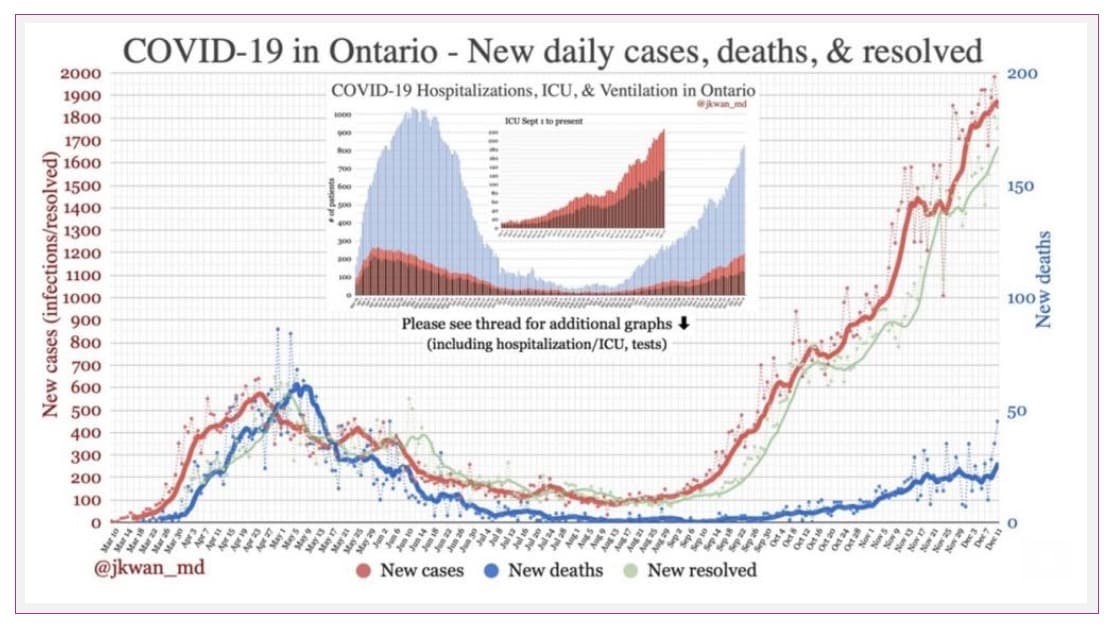
Resource: Dr. Jennifer Kwan Twitter
Sadly, this is pretty self-explanatory.
We are absolutely in a huge tsunami of the second wave in Ontario.
The mortality rate is far lower than the case rate we know more now, and with proper therapy (with steroids for example) we are preventing many deaths.
This is very good news.
People are still getting sick enough to require hospitalization, ICU admission, and more people are dying than in the summer, and it is going up.
Who is getting COVID, and how quickly is it spreading?
Another superstar, Ryan Imgrund @imgrund, is a biostatistician and has demonstrated the most amazing things in COVID through his excellent infographics. In his case, a picture is worth many thousands of words.
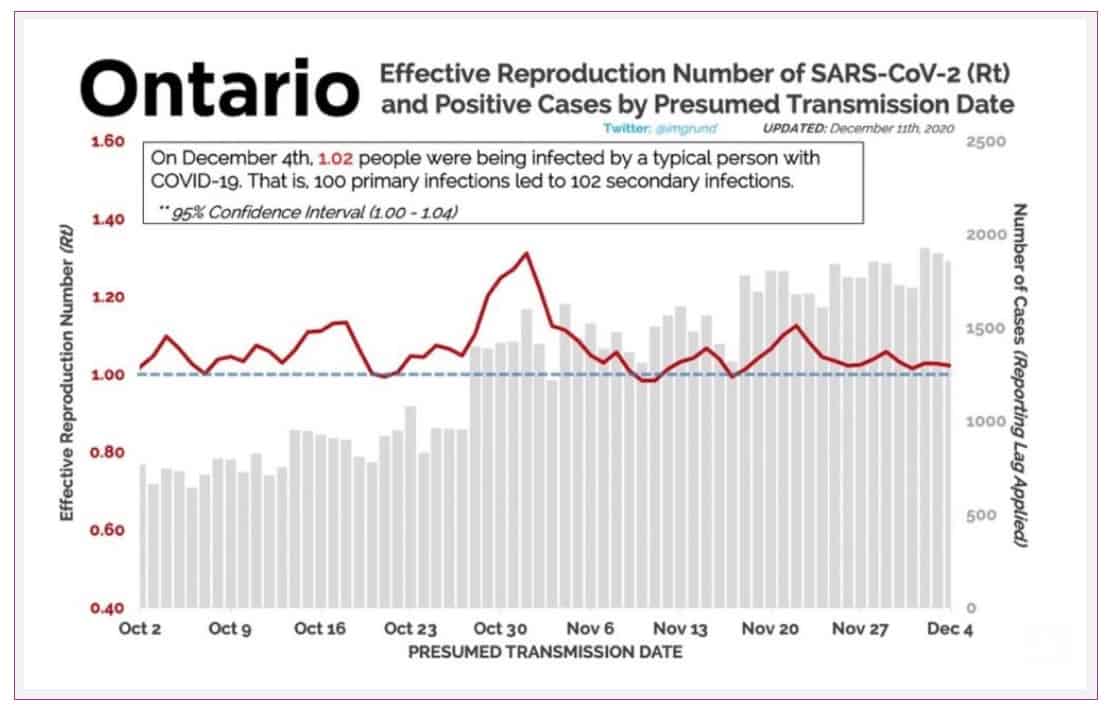
Resource: Ryan Imgrund Twitter
Above he shows what we call the ‘reproductive number (Rt)’. COVID-19 is thought to have a reproduction number of about 3 if no action is taken to stop its spread.
If the Rt is higher than 1, the number of cases increases exponentially, because each person with COVID passes it on to more than 1 person.
If the Rt is lower than 1, the disease will eventually stop spreading, because not enough new people are being infected to sustain the outbreak.
At the moment, the Rt in Ontario is 1.02.
This means that each person with COVID-19 is infecting 1.02 people.
100 people with COVID becomes 102 people with COVID.
This is why the numbers keep rising.
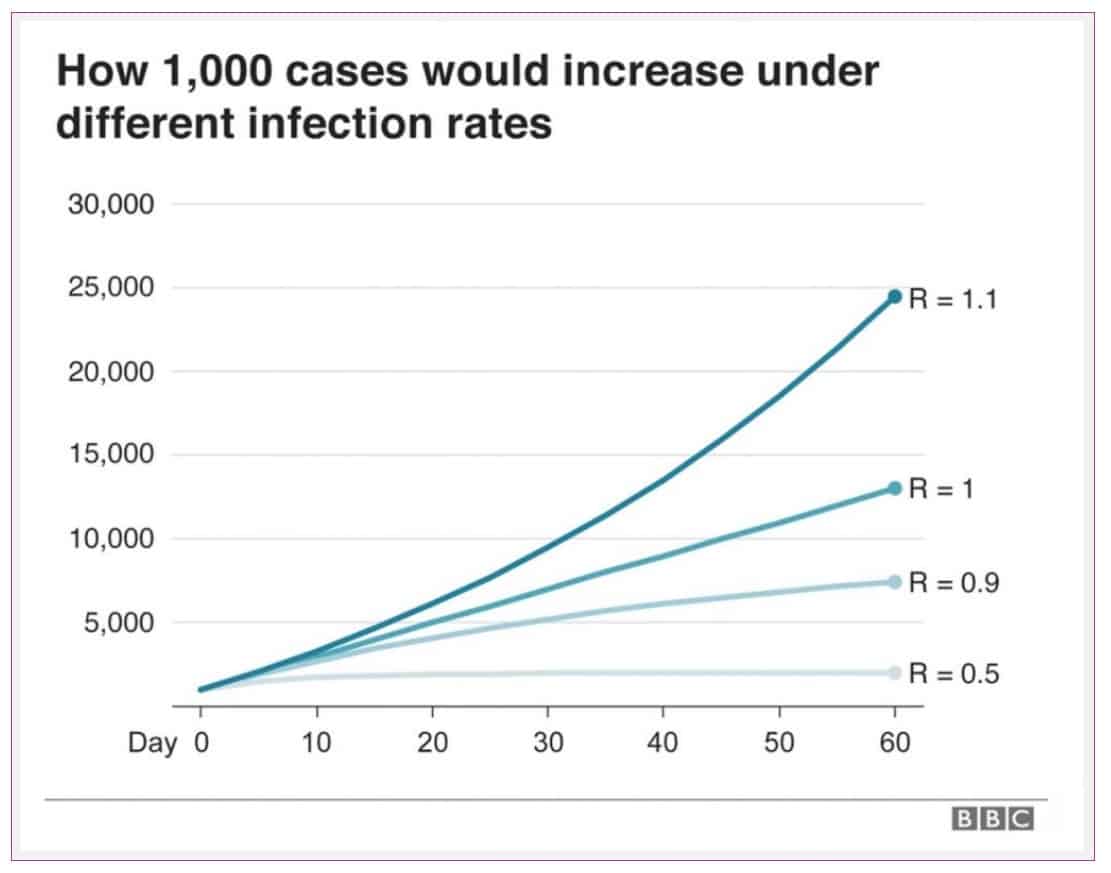
How are other provinces looking?

Here you can see why some provinces have a growing problem with COVID-19.
Northern Alberta, PEI, Newfoundland (the Atlantic Bubble was doing so well!), Quebec, and Saskatchewan, in particular, have to get this under control.
But any province with Rt over 1 are also needing to slow spread, and quickly, as each newly infected person is still infecting another 1+ person.
And so on…
How are schools doing?
There has been so much talk about how kids and schools are faring.
Here’s the thing: kids are absolutely getting COVID.
I have seen a DRAMATIC rise in my own patients testing positive for COVID-19 this week.
One day I had three of my own patients test positive, along with several of their family members.
This is concerning.
(I did not examine any of these kids, by the way, I spoke to the families virtually, see ‘Silver Linings’, below).
However, kids are still remaining pretty healthy.
Very few kids get sick enough from COVID to be admitted.
Almost no kids get admitted to ICUs or die.
But they can and do get COVID-19, and they may feel crummy.
And kids can infect their parents and grandparents and other loved ones.
And it’s a huge burden and annoyance for their families.
Testing is annoying.
Waiting for results is annoying.
Isolating for 10-14 days is annoying.
Especially when kids want to be in school and daycare before the holiday break.
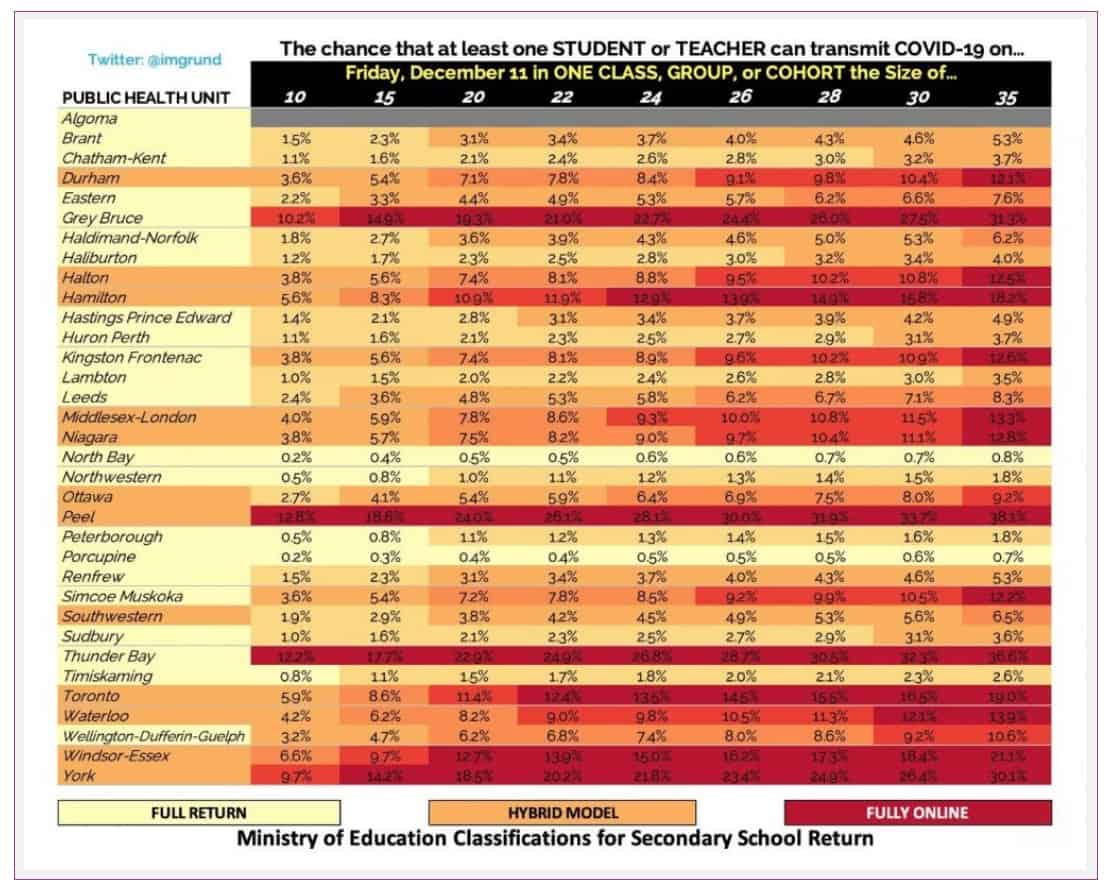
As you can see above, Ryan Imgrund demonstrates well that increased class size pretty dramatically increases the risk that a child will be exposed to COVID-19.
This is the same as entering a busy household, or mall, or restaurant.
More people in one space is a recipe for exposure and potential infection.
Take a look at Peel.
If you are a child in a 35-kid classroom in Peel, you have an almost 40% chance of being directly exposed to COVID.
Holy moly! (That’s why it is fully online!)
This is also helpful:
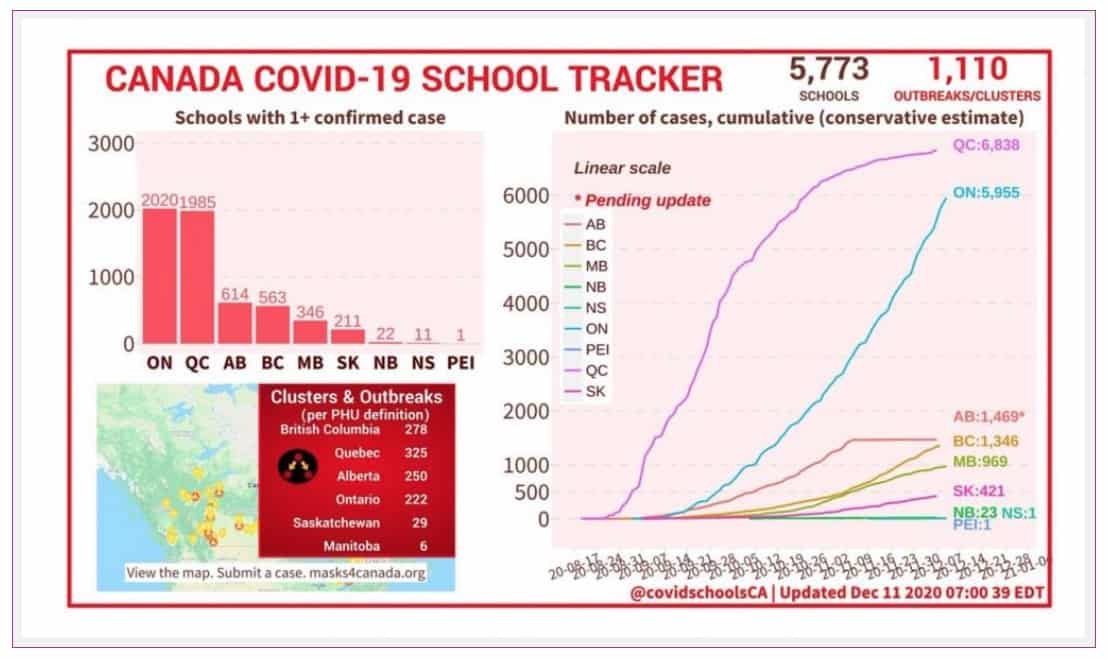
Lots of kids in lots of schools across Canada have kids or teachers with confirmed COVID-19.
How is the world doing?
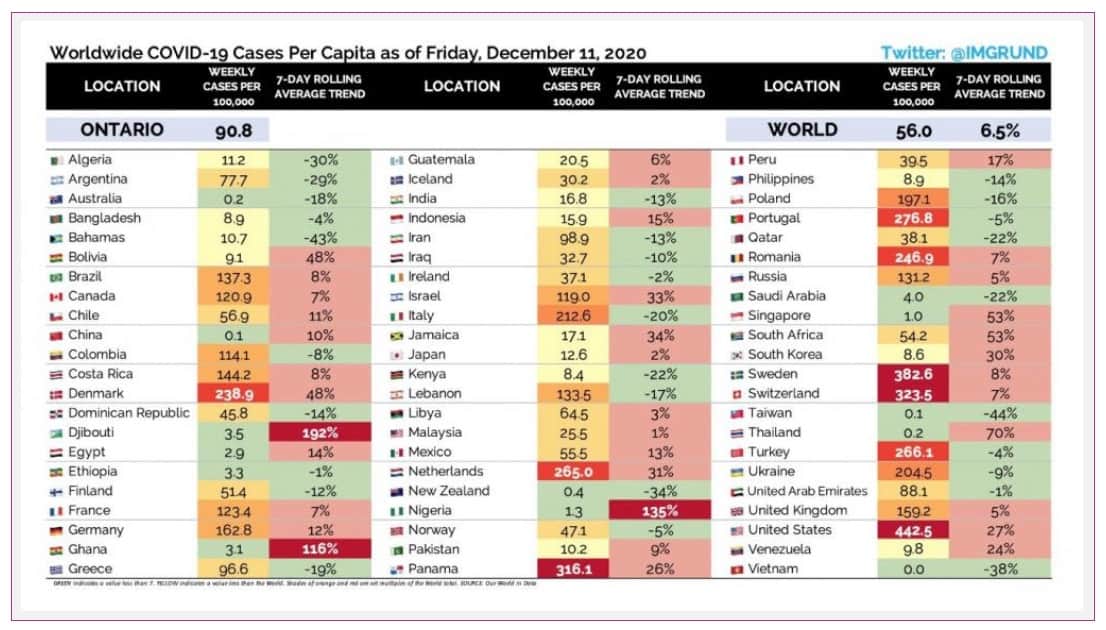
Another beauty by Ryan (thanks buddy!).
This shows the cases of COVID-19 per 100,000 people, and whether the trend is up or down.
Some outlier countries that are not faring well: Djibouti, Ghana, Nigeria, Thailand.
Note, however, how few cases per 100,000 this represents though.
These have rolling trends that are increasing, but only 0-4 new cases per 100,000 people.
Notice also some successes:
Australia and New Zealand; countries we have spoken about at length in other newsletters as models for COVID-19 containment.
China, Taiwan, and Vietnam are doing exceedingly well too.
Alright, let’s dive into the good news!
People around the world are actually getting a COVID-19 vaccine right now!
How incredible is that?
Within a year, the world worked together to create brand-new vaccines, using new vaccine-technology.
Vaccines that work!
Really remarkable!
Here are some of the vaccines that show promise:

This week, Health Canada and the US the Food and Drug Administration authorized Pfizer’s Covid-19 vaccine for use.
Canada was the third country to authorize its use, and the US became the 6th, in addition to Britain, Bahrain, Saudi Arabia, and Mexico.
This week saw a complicated coordination effort from vaccine manufacturers, shipping companies, health officials, hospitals, pharmacies, levels of the military, and governments to bring the vaccine to Canada and the United States while ensuring the vaccine remains at -70 degrees Celsius!
This is the most complex vaccination campaign in world history.
Keeping the doses at -70 degrees is no small feat.
We will most certainly see delays in vaccine timelines, debates about who should get the vaccine and when, and we will continue to learn more about COVID-19.
How long will vaccinated individuals remain immune?
Will a vaccine reduce the risk of transmission completely?
Do we still have to wear masks and social-distance even after vaccination?
Will COVID-19 mutate, rendering the vaccine less effective?
There are so many questions left unanswered, and perhaps even not yet considered.
The idea with mass vaccination strategies is ultimately reaching herd immunity, which does require much of the population to get vaccinated.
Each person who gets the vaccine moves the community one step closer to herd immunity, decreasing the amount of COVID-19 circulating in that community.
Less COVID circulating leads us closer to our ‘normal life’.
Even once people are vaccinated, it takes about a month to have immunity.
The Pfizer vaccine requires two vaccine doses, 3 weeks apart, and only a week later is a person considered immune.
Many of you want to know who will likely receive the COVID-19 first.
Each country, province, state, and region may have different strategizing, but the likely rollout goes something like this:
Health care workers and long-term care home residents and staff
This strategy is meant to preserve the health-care system and prevent more deaths, which has been highest in residents of long-term care homes.
Even within this group, there will likely be subcategorization – previous COVID-19 infection likely confers some immunity, so these individuals may wait longer for vaccination.
Those in direct contact with patients will likely be prioritized, such as ICU and emergency doctors, sanitation staff and nurses.
Importantly, we know the vaccine can offer protection to the individual who receives it, but we do not yet know if the vaccines prevent people from spreading COVID-19 asymptomatically to others.
This data is expected early in 2021.
In addition, if a vaccine is 90% effective, 10% of people are still at risk even if they receive the vaccine.
For this reason, in addition to the length of time needed to achieve immunity and the lack of clarity about asymptomatic spread from the vaccinated individual, we are going to be wearing masks, distancing and minimizing group sizes for a while.
What will be great is for those at high-risk, such as residents in long term care facilities, to be able to socialize together again, albeit in small groups.
The isolation over many months may be lessened, if only a little.
And this could be life-changing for many.
How many vaccines will arrive, and when, and who will receive them, and how will they be stored, and many other questions still need to be answered.
Who will likely receive the next round of COVID-19 vaccines?
Up next will likely be essential workers and adults at higher risk for COVID-19 infection.
What exactly constitutes an essential worker though?
Many would argue that teachers are at high risk.
What about grocery store clerks?
Daycare providers?
Plumbers?
This is a very subjective judgment call and will require a ton of conversation.
It will likely vary greatly based on where you live.
And what counts as high risk?
What’s the age cut off?
60?
70?
69 versus 70?
Is heart disease a higher risk than diabetes?
What about high blood pressure?
So many things to consider.
Finally, the general public will be offered the COVID-19 vaccine.
This is far away and requires even more planning.
We give plenty of vaccines at Kidcrew, but certainly don’t have the capacity to keep vaccines at -70 degrees.
Will the world have enough vaccines to give to everyone?
How long does immunity last?
Do we need to revaccinate every 3 months?
6 months?
2 years?
We’ll need more doses for that too.
How difficult will it be to scale these new mRNA vaccines?
In Ontario, the government pharmacy ran out of seasonal flu vaccines in November.
November!
Flu season hasn’t started yet!
Ensuring we have enough vaccines is not a small ask.
When will kids get vaccinated?
What about people who are pregnant or breast/chest feeding?
I have no idea.
The vaccine is being rolled out to people who received the vaccine in studies, and were shown to develop immunity and had no major identifiable vaccine-related side effects.
It wasn’t studied in kids or pregnant or breast/chest feeding individuals.
We don’t know if it works in these populations.
We don’t know if it is safe for these populations.
More to come!
How will vaccination change our lives?
Perhaps as people get vaccinated, small gatherings can occur again, as long as those in attendance are vaccinated.
But large-scale gatherings like concerts won’t likely be possible until there is widespread vaccination, and even then, likely still with distance and masks.
COVID-19 is not likely to, ‘poof, disappear’, even with a vaccination strategy.
Influenza still exists right?
It circulates every year, around the world.
We will need to remain vigilant and mindful of risk.
Even with a vaccine.
Why do I mention this?
Because I am hearing far too many people tell me, ‘Dr. Dina, the vaccine is coming, I am so eager to get rid of my mask and go to parties again.’
I am sorry, but there is a long way to go before we get there.
Perhaps years. I need you to be realistic.
Us throwing away our masks and having holiday get-togethers is premature and unwise.
Please look at the evidence.
As Rochelle Walensky, President-elect Biden’s pick for CDC director, said this week, “If I have a cup of water, I can put out a stove fire. But I can’t put out a forest fire, even if that water is 100% potent.
That’s why everyone must wear a mask.
As a nation, we’ll recover faster if you give the vaccine less work to do when it’s ready.”
Wow, that was a long one.
Hope it was informative!
Here is what I am thankful this week:
1. Time –
I am so much more aware of how I spend my time. Every second with my kids and husband is savored. Really. I find myself aware of my interactions with them in a much more granular way. And I constantly remind myself how incredibly lucky I am for having them in my life, for our health, and our fortune in living in a safe place with plenty of resources.
2. Gratitude –
Much like the above, I find myself so incredibly grateful. For my health, for my family, for a job I love, for my incredible #TeamKidcrew, for the awesome patients and families, I get to interact with every day. For all of it. And I am hearing from dozens of people every day that they too are grateful and mindful of the blessings in their lives, even in a time of much grief and sorrow.
3. Virtual medicine –
The ability to take care of patients virtually has changed our lives. I can chat with families or hop on a video chat with ease. Far fewer patients have to trek in to see me in person, and we keep the risk of exposure down. It is an incredible silver lining that I am immensely thankful for.
Thank you for sharing your precious time with me.
I am mindful that in your busy days and weeks, reading this long update takes time away from many other important things, and I am grateful to be part of your day.
Have an incredible week and a very happy holiday season.
Please remember to wear a mask, keep your distance, practice diligent hand hygiene, stay home if you are sick, and consider not just yourself and your family, but your whole community and the safety and health of all of us, as you are moving about in the world.
Until next time,
Stay healthy and safe,

Dr. Dina Kulik

![[Dr. Dina News] IMPORTANT UPDATE re. VIRTUAL CARE](https://drdina.ca/wp-content/uploads/2021/01/dr-dina-kulik-kids-and-virtual-care-1a-400x250.jpg)
![[Dr. Dina News] COVID-19 Vaccine for Infants and Young Children.](https://drdina.ca/wp-content/uploads/2021/04/dr-dina-kulik-kids-and-vaccines-400x250.jpg)
![[Dr. Dina News] COVID-19 Vaccine for Infants and Young Children.](https://drdina.ca/wp-content/uploads/2022/04/DRD-1-400x250.jpg)






